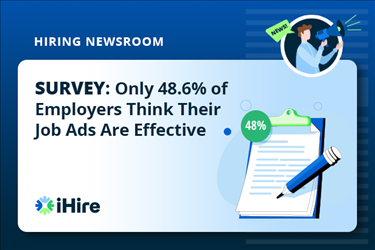- Employer Resources
- |
- Last Updated: February 08, 2023

Want to Attract Top Talent? Start With Job Ad SEO
The Keywords in a Job Description Will Make or Break Your Job Posting
If you ask savvy recruiters and HR pros how to write a great job posting, it won’t be long before they begin talking about job search keywords and job ad SEO (search engine optimization). For the uninitiated, implementing SEO for job posts can be a bit intimidating, but it really comes down to properly utilizing keywords in a job description and paying attention to some of the structural elements and current best practices that will maximize your job posting SEO.
Keywords, Keywords, Keywords!
If you’re really interested in learning how to write a great job posting, start by performing research into job search keywords. SEO for job posts is no different than any other SEO initiative. It all starts with keywords. If you don’t know what your audience is looking for, there’s no way you can incorporate those keywords in a job description.
iHire offers great tools for employers that help with search engine optimization, like the Job Optimizer, which helps hiring managers identify which job search keywords to add to their postings. Our Job Ad Builder does the hard work for you and guides you through the process of creating a job ad so you can be sure your posting will stand out in search results.
As you begin to compile your job search keywords and prepare to write your job posting, keep the following types of keywords in mind:
- Job Title: Don’t be cute. If you want to internally name a position “Sales Unicorn” or “Marketing Overlord,” that’s your business. When it comes to job posting SEO, those off-the-wall titles are bad news because, quite simply, very few people search for them and they look odd in search results.
- Location: Keep the focus local. Most people search for job openings in a specific city or geographic area. Include that information in a prominent location. Additionally, remote work is frequently sought after these days. So, if the position is compatible with remote work, be sure to emphasize that in the ad.
- Industry-Specific Terms/Phrases: Are you looking for a particular skill or credential? Make sure you mention it, especially if it’s rare or in high demand.
- Abbreviations/Acronyms: Does your industry or company love to confuse people with shortened terms and initials? Boost your job ad SEO by spelling out those words in addition to using the abbreviated versions.

Speak the Same Language as Job Seekers
This goes hand in hand with your research into job search keywords. Your job post needs to speak directly to your desired candidate, using language that will resonate with them. To do this, you must identify who your perfect candidate is and find out what they are typing into search engines.
Don’t have time to conduct market surveys, review job seeker forums, and/or pore over search results on Google Trends? Start by checking out the language some of your competitors are using and look for similar positions on job boards (like iHire) and search engines (like Google or Bing) to see what you come up with.
Create Your Account Today
Do the Little Things to Optimize Your Landing Page
To get the most “juice” out of your SEO efforts, you need to optimize your job posting’s landing page. This means utilizing those keywords you compiled during your research and inserting those terms and phrases into strategic areas of the webpage to maximize your job ad’s search engine ranking.
Focus your efforts on the four most important SEO elements of your job posting’s landing page:
- URL: Keep the web address for your job posting simple and straightforward, which will make it more likely to be crawled by search engines. Make sure your URL contains the job title and location. If your brand is well known, work in the company name as well.
- Page Title: Your page title informs visitors (and search engines) what information is available, so include the job title, location, and company name in this vital area. For best results, keep your page title to less than 60 characters.
- Meta Description: The meta description allows you to go a bit further than your page title and provide a short summary of what the page is about. Technically, there are no character limits, but most search engines will only display the first 165 characters. Keep the reader in mind—you want to drive them from the search engine results page to your job ad!
- Header Tags: Header tags impose hierarchy and provide structure for a page’s content. These tags are labeled in significance from h1 (most important) to h6 (least important). Reserve the h1 tag for the job title and use the other tags to label parts of the job posting like the company information, job description, qualifications, and benefits/compensation sections.
Pay Attention to Mobile Experience
As job seeker turn to their smartphones and tablets to surf the web, they are also reviewing opportunities and applying for positions via mobile at a much higher rate than a few years ago. Because of this, you have to keep mobile users in mind when developing your job ad.
The benefits of mobile optimization extend beyond job seekers, though. Google gives mobile-friendly websites a search ranking boost, so if your site is not optimized for mobile visitors, you’re missing out on serious traffic. Furthermore, mobile optimization is quickly becoming the industry standard. It’s pretty simple, really: pay attention to mobile experience or get left behind.
Voice Search and Long-Tail Keywords
With the advent of voice search assistants like Alexa, Siri, and Google Assistant, a whole new world of job ad SEO has opened up for employers and recruiters. The prevalence of voice searches has increased the use of long-tail keywords—very specific phrases—which are more likely to be spoken than typed.
This is just another thing to keep in mind when incorporating keywords in a job description. Although voice search is just beginning its rise, use of this technology promises to grow over the coming decade. Some surveys show that 41% of adults use voice search at least once per day.
The next time you need to hire, try incorporating the approaches and techniques mentioned above. Getting your job posting to rank highly in search engines will significantly increase the amount of attention your job ad receives. Finding great talent has always been a numbers game, so make sure that your job posting gets in front of as many of the right eyes as possible by implementing proper job ad SEO practices.

Originally Published: September 30, 2022





